Non-Linear Programming-Based Energy Management for a Wind Farm Coupled with Pumped Hydro Storage System
Abstract
:1. Introduction
2. Energy Management System
3. Power Forecasting
3.1. Kernel Principal Component Analysis (KPCA)
3.2. Random Forest Technique
3.3. Evaluation Criteria
4. Short-Term Wind Energy Forecasting Using Random Forest
5. Modelling of the Grid-Connected Wind Farm-PHES
5.1. Wind Farm Modelling
5.2. PHES Modelling
6. Optimization of the EMS for the Wind Farm Coupled with PHES
6.1. Day-Ahead Optimization
6.1.1. Problem Formulation
6.1.2. Variables Decision
- Psto: The storage power generated is considered as the variable that describes the way of storing and discharging the reservoir. Moreover, it allows the satisfying of the load power. This power represents both the storage power in turbining mode, Phyd, and the storage power in the pumping mode, Ppump.
- Vol: The volume of the reservoir from which the storage capacity is defined.
6.1.3. Constraints
6.1.4. Objective Function
6.2. Nonlinear Programming-Based EMS Optimization
- Min f(x); x∈ RN
- The constraints are g(x) ≤ 0 and Lb < x< Ub
6.3. Results and Discussion
7. Conclusions
Author Contributions
Funding
Conflicts of Interest
Nomenclature
| Renewable Energy Source | RES | Deep Neural Network | DNN |
| Energy Management System | EMS | Regression Tree | RT |
| Energy Storage System | ESS | Classification and Regression Tree | CART |
| Pumped Hydro Energy System | PHES | Squared Prediction Error | SPE |
| Random Forest | RF | Mean Absolute Error | MAE |
| Kernel Principal Component Analysis | KPCA | Root Mean Squared Error | RMSE |
| Non-Linear Programming | NLP | Mean Absolute Percentage Error | MAPE |
| Compressed Air Energy Storage | CAES | Input data | x |
| Machine Learning | ML | Output data | y |
| Support Vector Regression | SVR | Measured Wind Power | Pwind |
| Multiple Linear Regression | MLR | Predicted Wind power | |
| Decision Tree | DT | Rate | Q |
| Feature Extraction and Selection | FES | Volume of reservoir | Vol |
| Photovoltaic | PV | Reservoir Energy | E |
| Independent Component Analysis | ICA | Head of Reservoir | H |
| Partial Least Squares | PLS | Pumped Power | Ppump |
| Deep Learning | DL | Hydraulic Power | Phyd |
| Recurrent Neural Network | RNN | Storage Power | Psto |
| Deep Belief Network | DBN | Grid Power | Pgrid |
References
- Reihani, E.; Sepasi, S.; Roose, L.R.; Matsuura, M. Energy management at the distribution grid using a Battery Energy Storage System(BESS). Int. J. Electr. Power Energy Syst. 2016, 77, 337–344. [Google Scholar] [CrossRef]
- Weitemeyer, S.; Kleinhans, D.; Vogt, T.; Agert, C. Integration of Renewable Energy Sources in future power systems: The role of storage. Renew. Energy 2015, 75, 14–20. [Google Scholar] [CrossRef]
- Anagnostopoulos, J.S.; Papantonis, D.E. Pumping station design for a pumped-storage wind-hydro power plant. Energy Convers. Manag. 2007, 48, 3009–3017. [Google Scholar] [CrossRef]
- Najeebullah; Zameer, A.; Khan, A.; Javed, S.G. Machine Learning based short term wind power prediction using a hybrid learning model. Comput. Electr. Eng. 2015, 45, 122–133. [Google Scholar] [CrossRef]
- Sasser, C.; Yu, M.; Delgado, R. Improvement of wind power prediction from meteorological characterization with machine learning models. Renew. Energy 2021, 183, 491–501. [Google Scholar] [CrossRef]
- Heinermann, J.; Kramer, O. Machine Learning Ensembles for Wind Power Prediction. Renew. Energy 2015, 89, 671–679. [Google Scholar] [CrossRef]
- Masini, R.P.; Medeiros, M.C.; Mendes, E.F. Machine Learning Advances for Time Series Forecasting; 802v3.econ.EM.9; Wiley: Hoboken, NJ, USA, 2021. [Google Scholar]
- Dhibi, K.; Fezai, R.; Mansouri, M.; Trabelsi, M.; Bouzrara, K.; Nounou, H.; Nounou, M. A Hybrid Fault Detection and Diagnosis of Grid-Tied PV Systems: Enhanced Random Forest Classifier Using Data Reduction and Interval-Valued Representation. IEEE Access 2021, 9, 64267–64277. [Google Scholar] [CrossRef]
- Dhibi, K.; Fezai, R.; Mansouri, M.; Trabelsi, M.; Kouadri, A.; Bouzara, K.; Nounou, H.; Nounou, M. Reduced Kernel Random Forest Technique for Fault Detection and Classification in Grid-Tied PV Systems. IEEE J. Photovolt. 2022, 10, 1864–1871. [Google Scholar] [CrossRef]
- Sheriff, M.Z.; Botre, C.; Mansouri, M.; Nounou, H.; Nounou, M.; Karim, M.N. Process monitoring using data-based fault detection techniques: Comparative studies. In Fault Diagnosis and Detection; InTech: Rijeka, Croatia, 2017; pp. 237–261. [Google Scholar]
- Li, S.Z.; Lu, X.; Hou, X.; Peng, X.; Cheng, Q. Learning multiview face subspaces and facial pose estimation using independent component analysis. IEEE Trans. Image Process. 2005, 14, 705–712. [Google Scholar] [CrossRef]
- Kembhavi, A.; Harwood, D.; Davis, L.S. Vehicle detection using partial least squares. IEEE Trans. Pattern Anal. Mach. Intell. 2011, 33, 1250–1265. [Google Scholar] [CrossRef]
- Cao, L.; Chua, K.; Chong, W.; Lee, H.; Gu, Q. A Comparison of PCA, KPCA and ICA for Dimensionality Reduction in Support Vector Machine; Elsevier B.V.: Amsterdam, The Netherlands, 2003. [Google Scholar] [CrossRef]
- Salcedo-Sanz, S.; Cornejo-Bueno, L.; Prieto, L.; Paredes, D.; García-Herrera, R. Feature selection in machine learning prediction systems for renewable energy applications. Renew. Sustain. Energy Rev. 2018, 90, 728–741. [Google Scholar] [CrossRef]
- Deng, X.; Shao, H.; Hu, C.; Jiang, D.; Jiang, Y. Wind Power Forecasting Methods Based on Deep Learning: A Survey. Comput. Model. Eng. Sci. CMES 2020, 122, 273–301. [Google Scholar] [CrossRef]
- Parastegari, M.; Hooshmand, R.A.; Khodabakhshian, A.; Forghani, Z. Joint operation of wind farms and pump-storage units in the electricity markets: Modeling, simulation and evaluation. Simul. Model. Pract. Theory 2013, 37, 56–69. [Google Scholar] [CrossRef]
- Gao, J.; Zheng, Y.; Li, J.; Zhu, X.; Kan, K. Optimal model for complementary operation of a photovoltaic-wind pumped storage system. Hindawi Math. Probl. Eng. 2018, 2018, 5346253. [Google Scholar] [CrossRef]
- Hozouri, M.A.; Abbaspour, A.; Fotuhi-Firuzabad, M.; Moeini-Aghtaie, M. On the use of pumped storage for wind energy maximization in transmission-constrained power systems. IEEE Trans. Power Syst. 2015, 30, 1017–1025. [Google Scholar] [CrossRef]
- Shi, N.; Zhou, S.; Su, X.; Yang, R.; Zhu, X. Unit Commitment and Multi-Objective Optimal Dispatch Model for Wind-Hydro-Thermal Power System with Pumped Storage. In Proceedings of the 2016 IEEE 8th International Power Electronics and Motion Control Conference (IPEMCECCE Asia), Hefei, China, 22–26 May 2016. [Google Scholar]
- An, L.N.; Quoc-Tuan, T. Optimal energy management for an island micro grid by using Dynamic programming method. In Proceedings of the 2015 IEEE Eindhoven Power Tech, Eindhoven, The Netherlands, 29 June–2 July 2015. [Google Scholar]
- Duque, J.; Castronuovo, E.D.; Sanchez, I.; Usaola, J. Optimal operation of a pumped-storage hydro plant that compensates the imbalances of a wind power producer. Electr. Power Syst. Res. 2011, 81, 1767–1777. [Google Scholar] [CrossRef]
- Kumar, M.; Saini, P.; Kumar, N. Optimization of wind-pumped storage hydropower system. Int. J. Eng. Technol. Manag. Appl. Sci. 2016, 4, 67–75. [Google Scholar]
- Robyns, B.; Davigny, A.; Saudemont, C. Methodologies for supervision of hybrid energy sources based on storage system—A survey. Math. Comput. Simul. 2013, 91, 52–71. [Google Scholar] [CrossRef]
- Foley, A.M.; Leahy, P.G.; Marvuglia, A.; McKeogh, E.J. Current methods and advances in forecasting of wind power generation. Renew. Energy 2011, 37, 1–8. [Google Scholar] [CrossRef]
- Costa, A.; Crespo, A.; Navarro, J.; Lizcano, G.; Madsen, H.; Feitosa, E. A review on the young history of the wind power short-term prediction. Renew. Sustain. Energy Rev. 2008, 12, 1725–1744. [Google Scholar] [CrossRef] [Green Version]
- Blum, A.L.; Langley, P. Selection of relevant features and examples in Machine Learning. Artif. Intell. 1997, 97, 245–271. [Google Scholar] [CrossRef]
- Weston, J.; Mukherjee, S.; Chapelle, O.; Pontil, M.; Poggio, T.; Vapnik, V. Feature selection for SVMs. In Proceedings of the 13th International Conference on Neural Information Processing Systems; MIT Press: Cambridge, MA, USA, 2000. [Google Scholar]
- Schölkopf, B.; Smola, A.; Müller, K.R. Nonlinear component analysis as a kernel eigenvalue problem. Neural Comput. 1998, 10, 1299–1319. [Google Scholar] [CrossRef]
- Harkat, M.F.; Mansouri, M.; Nounou, M.; Nounou, H. Fault detection of uncertain nonlinear process using interval-valued data-driven approach. Chem. Eng. Sci. 2019, 205, 36–45. [Google Scholar] [CrossRef]
- Rathi, Y.; Dambreville, S.; Tannenbaum, A. Statistical shape analysis using kernel pca. In Image Processing: Algorithms and Systems, Neural Networks, and Machine Learning; International Society for Optics and Photonics: Washington, DC, USA, 2006; Volume 6064, p. 60641B. [Google Scholar]
- Choi, S.W.; Lee, C.; Lee, J.-M.; Park, J.H.; Lee, I.-B. Fault detection and identification of nonlinear processes based on kernel pca. Chemom. Intell. Lab. Syst. 2005, 75, 55–67. [Google Scholar] [CrossRef]
- Cui, P.; Li, J.; Wang, G. Improved kernel principal component analysis for fault detection. Expert Syst. Appl. 2008, 34, 1210–1219. [Google Scholar] [CrossRef]
- Alonso, Á.; Torres, A.; Dorronsoro, J.R. Random Forests and Gradient Boosting for Wind Energy Prediction; Springer International Publishing: Cham, Switzerland, 2015. [Google Scholar] [CrossRef]
- Lahouar, A.; Slama, J.B.H. Hour-ahead wind power forecast 1 based on random forests. Renew. Energy 2017, 109, 529–541. [Google Scholar] [CrossRef]
- Baumgart, A. Mathematical model of wind turbine. J. Sound Vib. 2002, 251, 1–12. [Google Scholar] [CrossRef]
- Jamii, J.; Abbes, D.; Mimouni, M.F. Joint operation between wind power generation and pumped hydro energy storage in the electricity market. Wind. Eng. 2019, 45, 50–62. [Google Scholar] [CrossRef]
- Bridier, L.; David, M.; Lauret, P. Optimal design of a storage system coupled with intermittent renewable. Renew. Energy 2014, 67, 2–9. [Google Scholar] [CrossRef]
- Quintero, F.C.; Padron, J.M.; Dominguez, E.M.; Santana, M. Renewable Hydro-Wind Power system for small Islands: The Elhierro Case. Int. J. Tech. Phys. Probl. Eng. ISS 2016, 8, 1–7. [Google Scholar]
- Whitefoot, J.W.; Mechtenberg, A.R.; Peters, D.L.; Papalambros, P.Y. Optimal Component Sizing and Forward-Looking Dispatch of an Electrical Microgrid for Energy Storage Planning. In Proceedings of the ASME 2011 International Design Engineering Technical Conferences and Computers and Information in Engineering Conference, Washington, DC, USA, 28–31 August 2011. [Google Scholar]
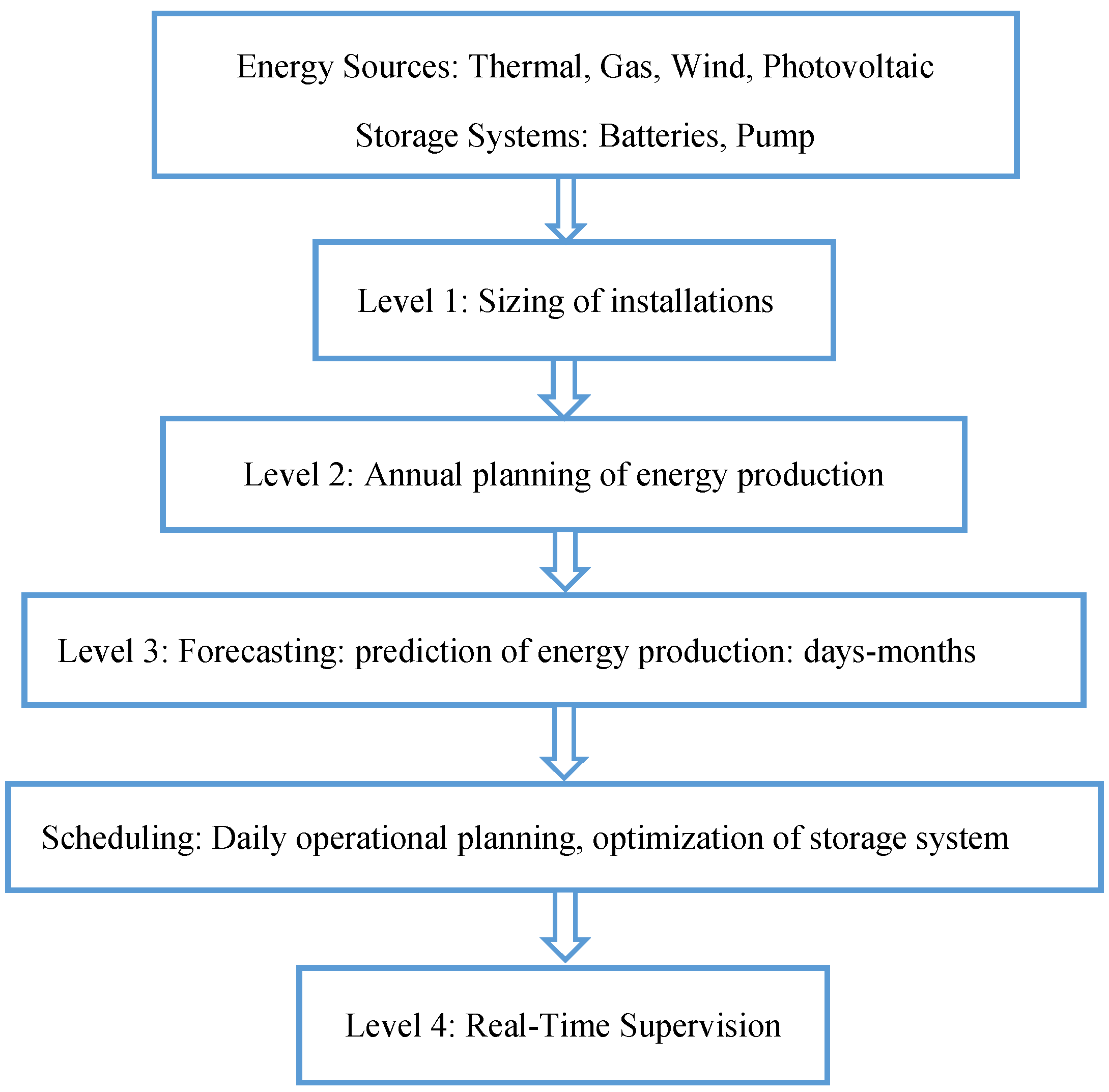
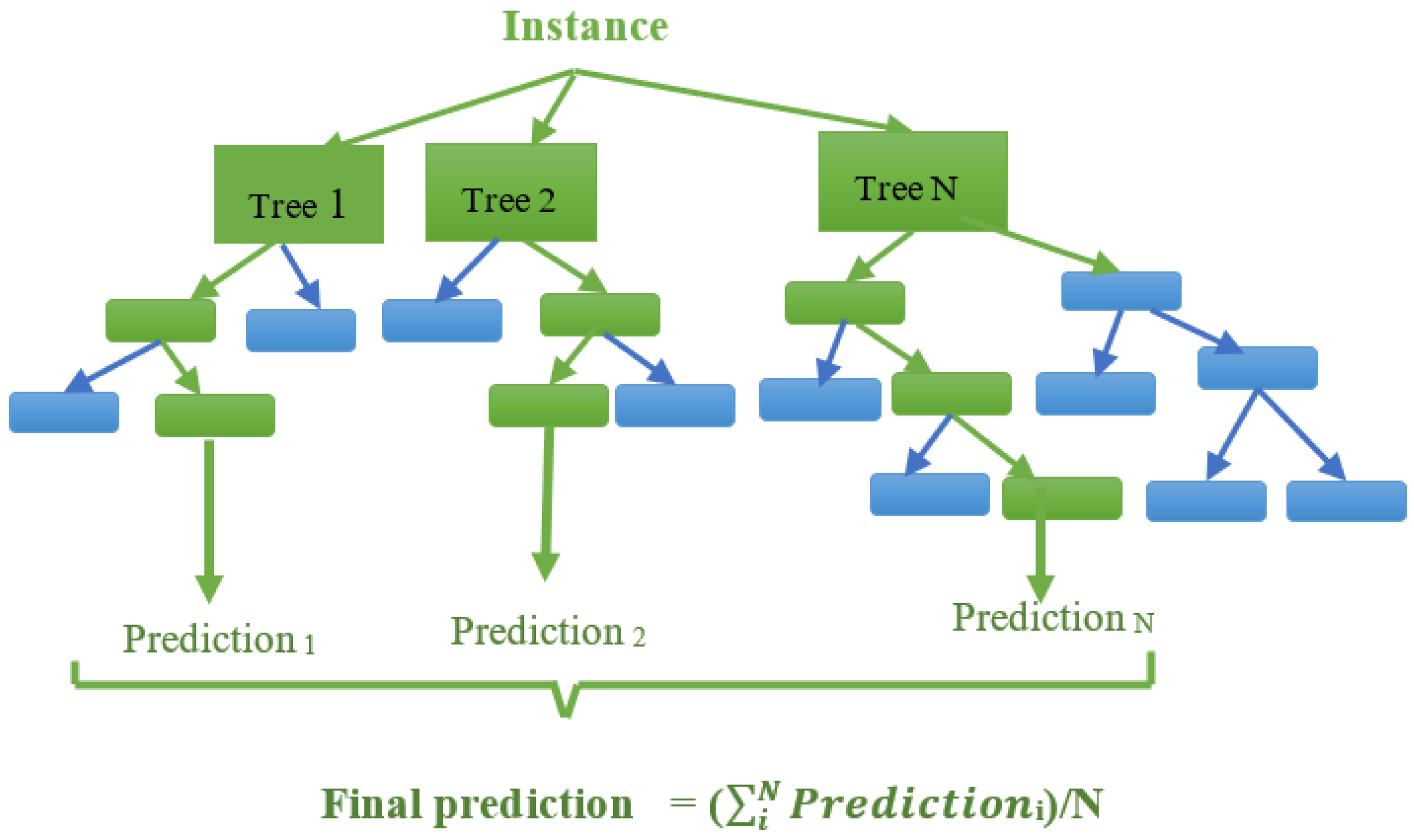
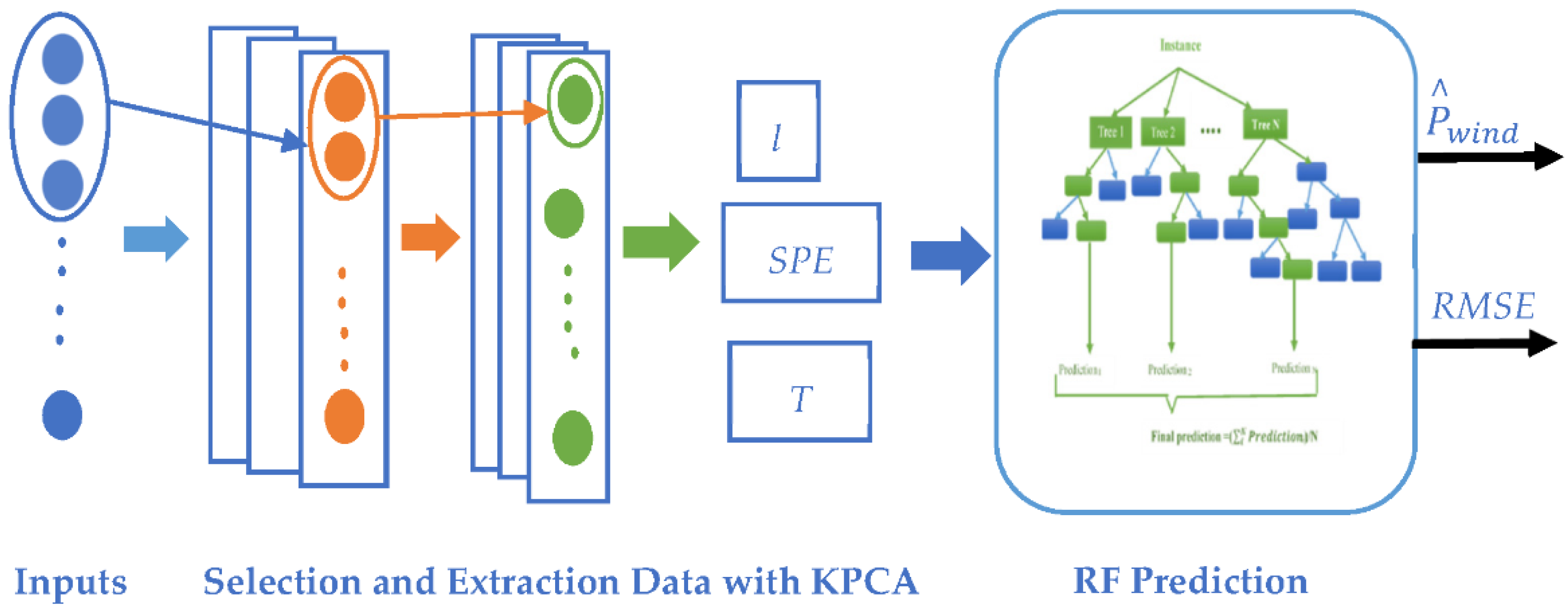
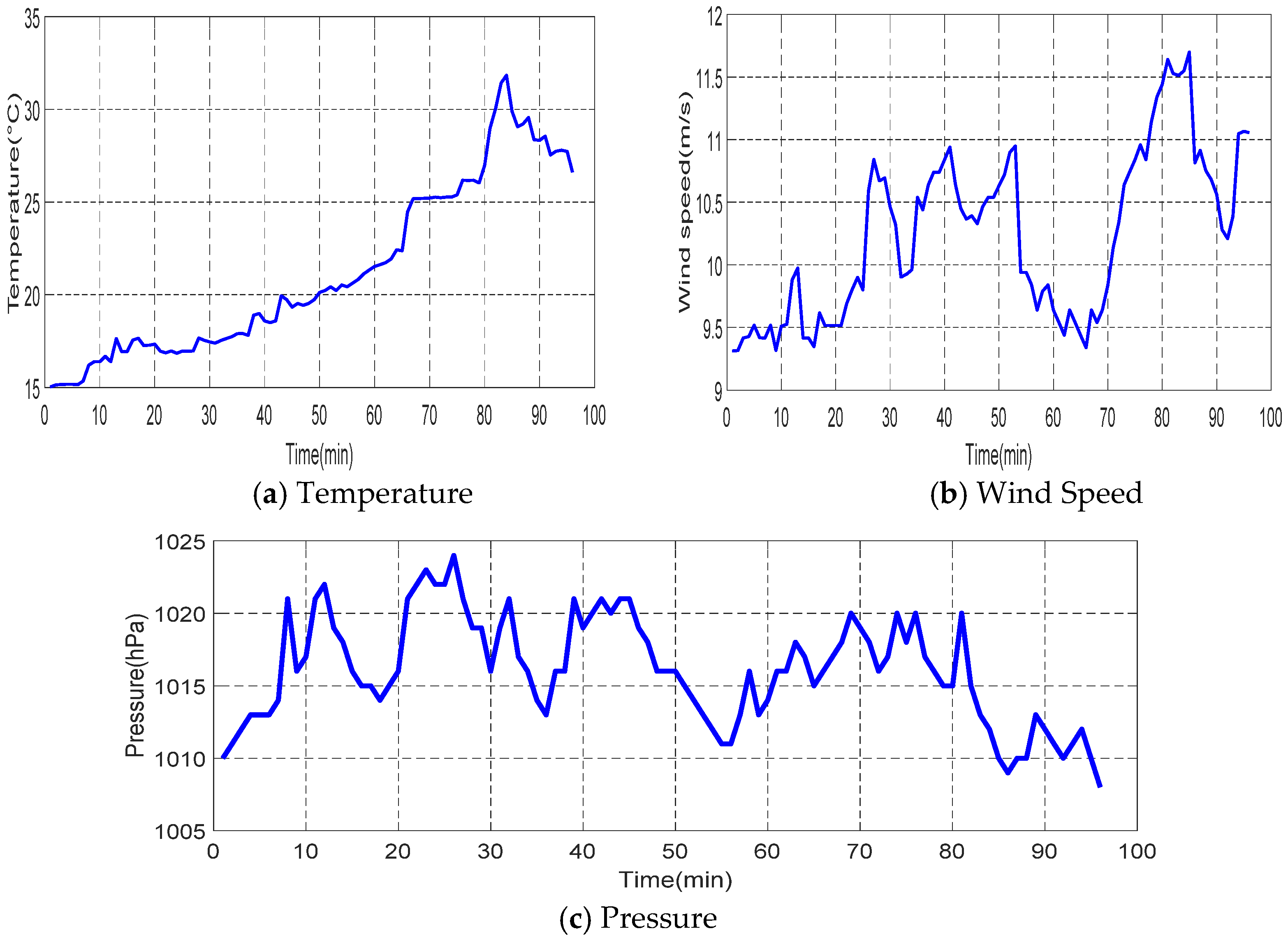
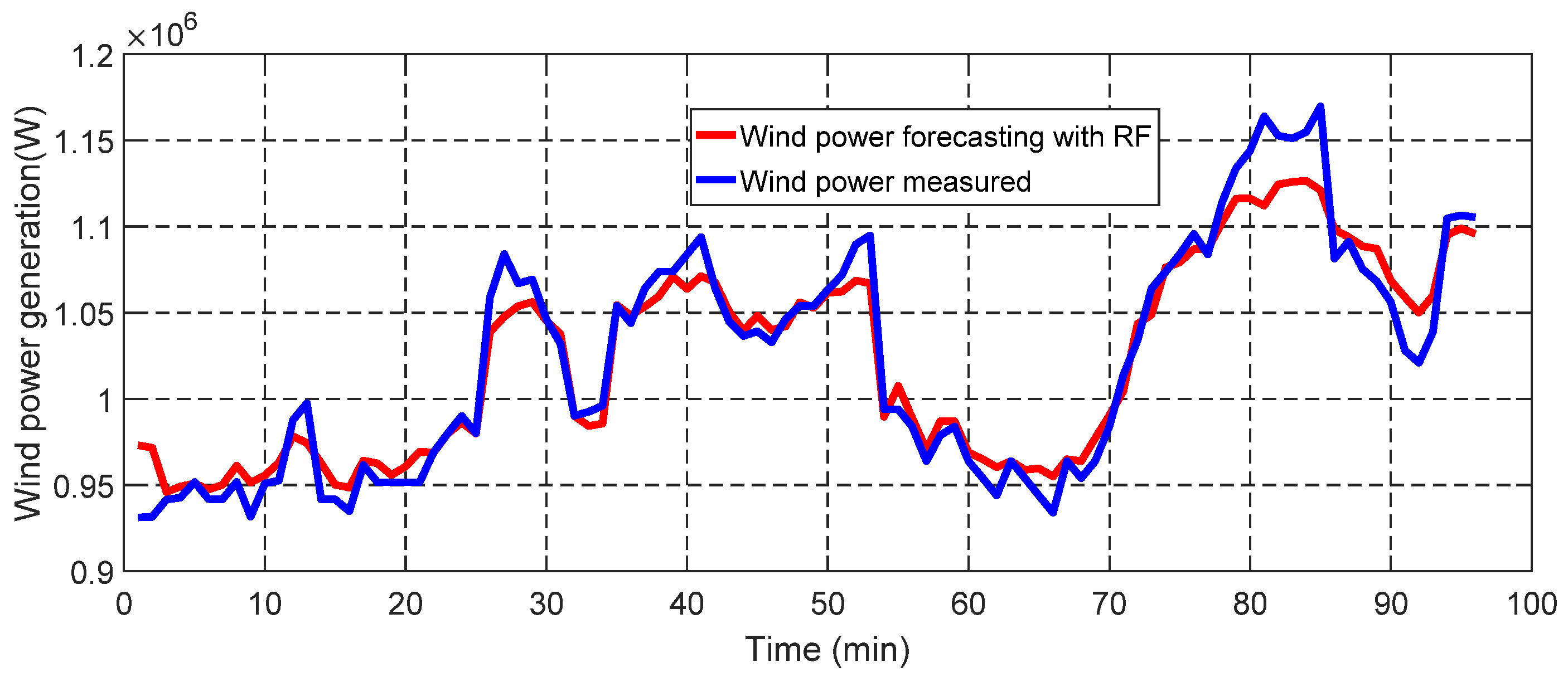
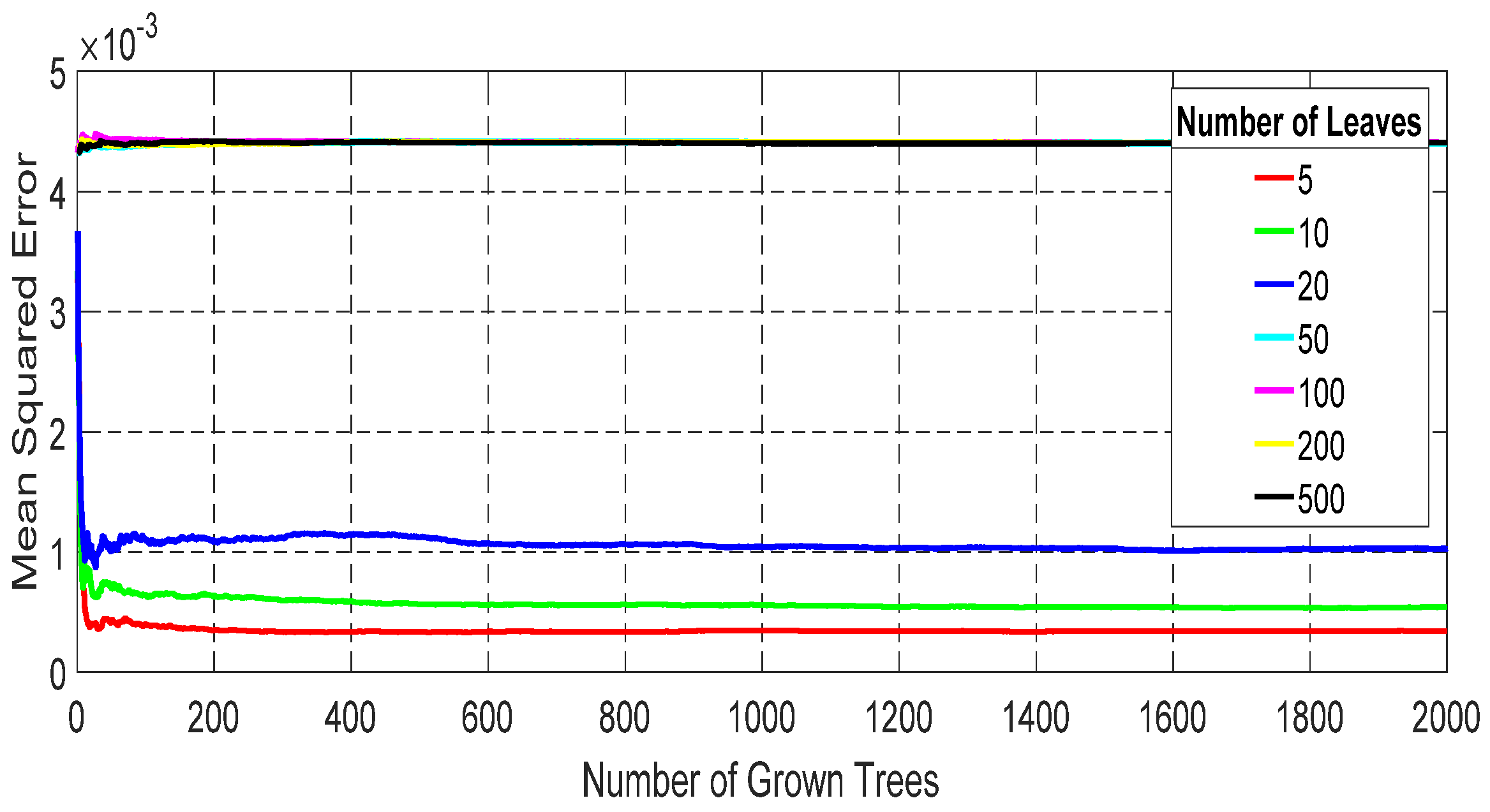
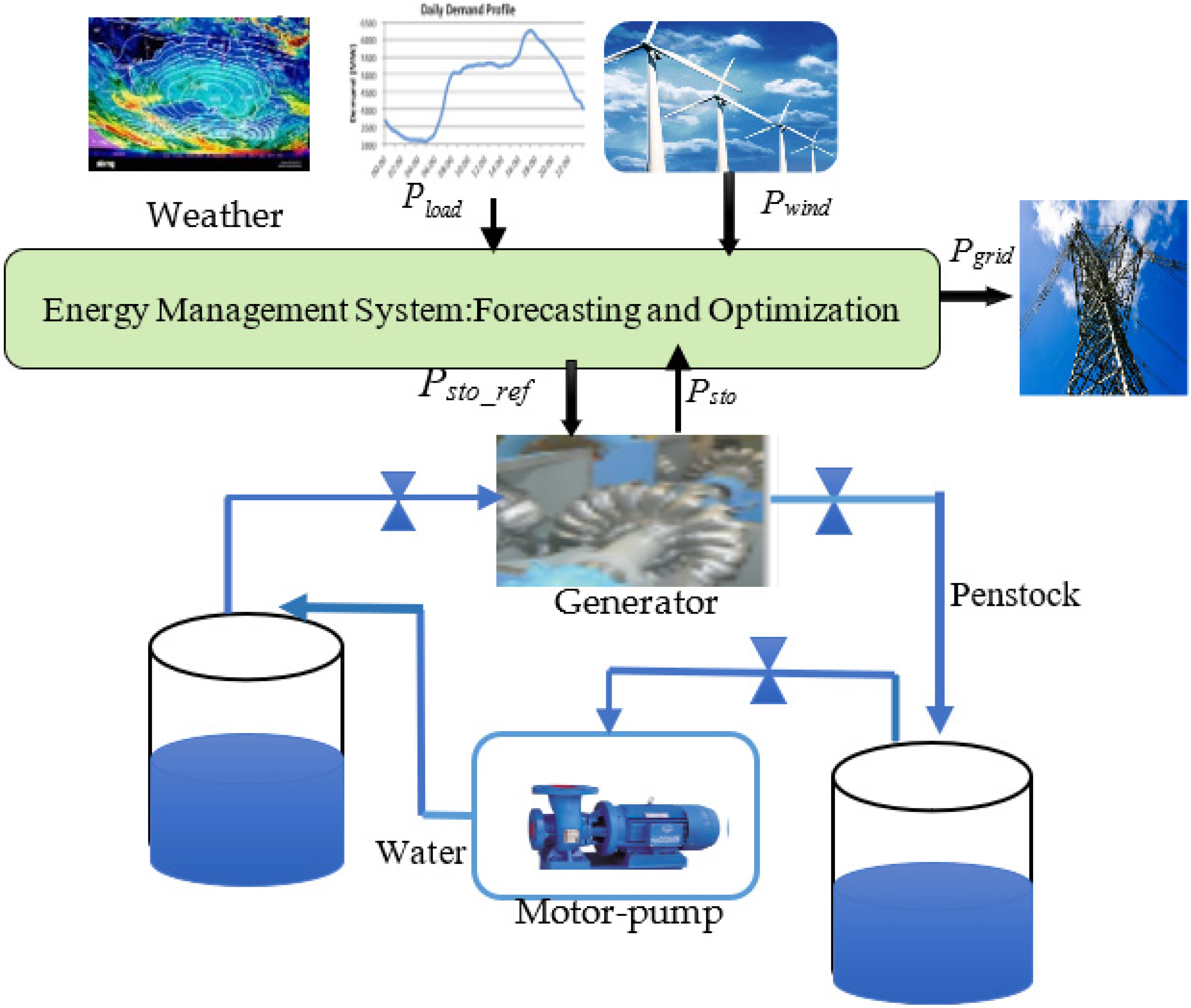
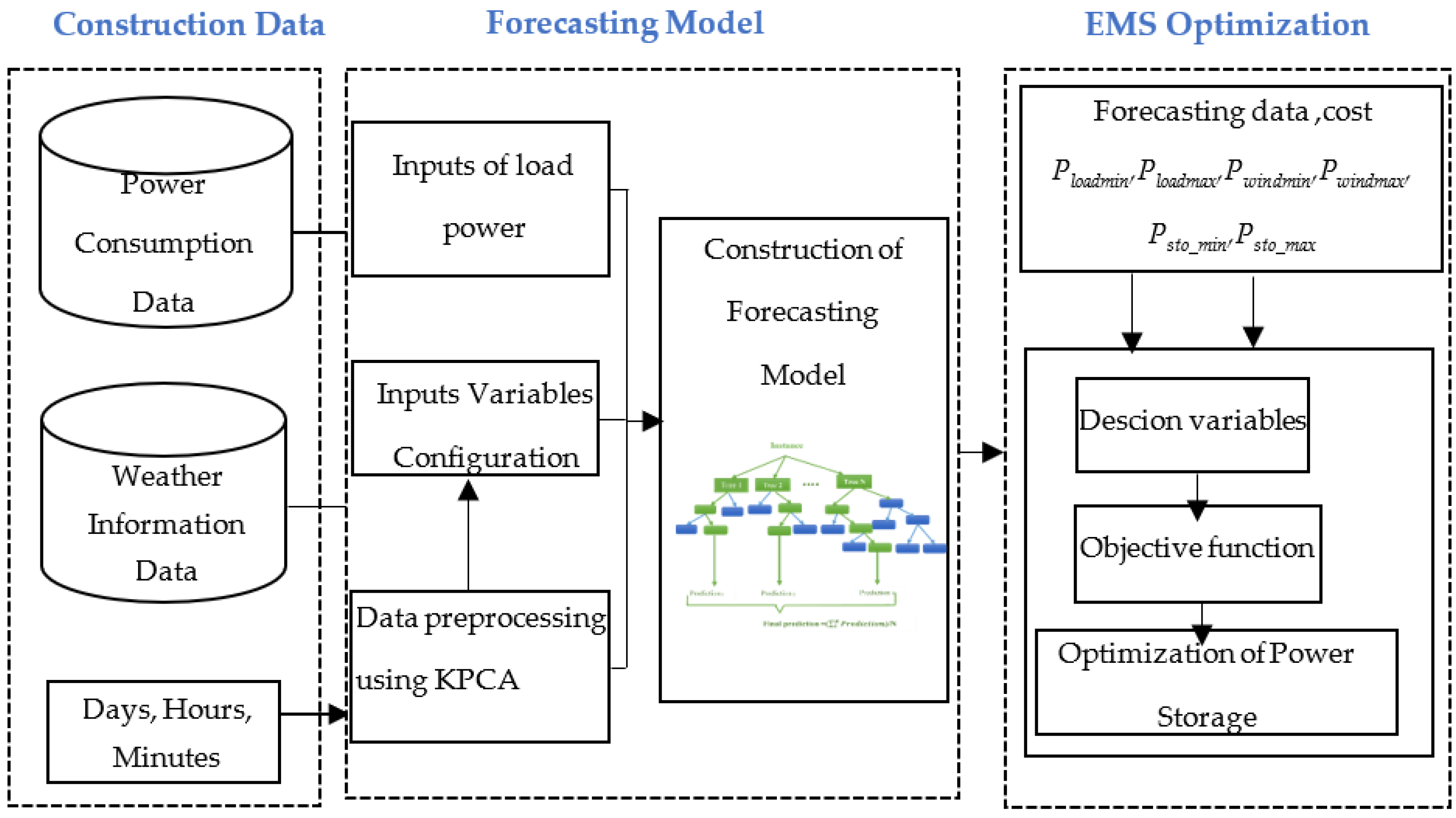
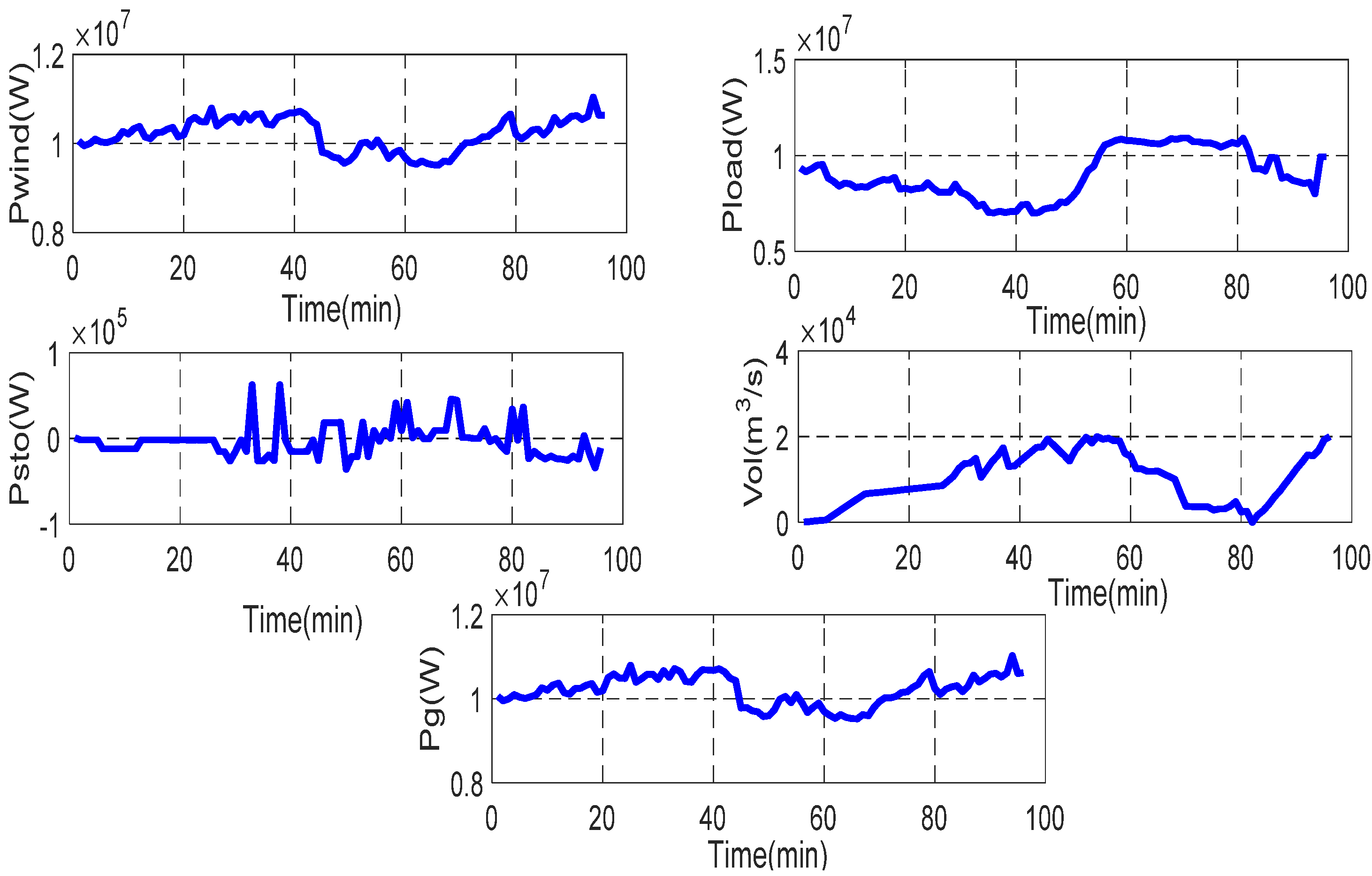

| Number of Leaves | RMSE(%) | MAE(%) | MAPE(%) |
|---|---|---|---|
| 5 | 2 | 6 | 3 |
| 10 | 5 | 10 | 2.5 |
| 20 | 10 | 20 | 5.5 |
| 50 | 15 | 27 | 8 |
| 100 | 15 | 27 | 10 |
| 200 | 16 | 30 | 11 |
| 500 | 17 | 30 | 12 |
| Variable | Minimal Value | Maximal Value |
|---|---|---|
| Pwind | Pwind_min | Pwind_max |
| Pload | Pload_min | Pload_max |
| Ppump | Ppump_min | Ppump_max |
| Phyd | Phyd_min | Phyd_max |
| E | Emin | Emax |
| Q | Qmin | Qmax |
| H | Hmin | Hmax |
| Starting Points | Pref1 | Pref2 |
|---|---|---|
| Penalty cost (k€) | 13 | 19.58 |
| Profit cost (k€) | 10 | 15.13 |
| CPU (seconds) | 8 | 9 |
| Starting Points | Pref1 | Pref2 |
|---|---|---|
| Penalty cost (k€) | 50 | 50.58 |
| Profit cost (k€) | 190 | 200 |
| CPU (seconds) | 24 | 26 |
Publisher’s Note: MDPI stays neutral with regard to jurisdictional claims in published maps and institutional affiliations. |
© 2022 by the authors. Licensee MDPI, Basel, Switzerland. This article is an open access article distributed under the terms and conditions of the Creative Commons Attribution (CC BY) license (https://creativecommons.org/licenses/by/4.0/).
Share and Cite
Jamii, J.; Trabelsi, M.; Mansouri, M.; Mimouni, M.F.; Shatanawi, W. Non-Linear Programming-Based Energy Management for a Wind Farm Coupled with Pumped Hydro Storage System. Sustainability 2022, 14, 11287. https://doi.org/10.3390/su141811287
Jamii J, Trabelsi M, Mansouri M, Mimouni MF, Shatanawi W. Non-Linear Programming-Based Energy Management for a Wind Farm Coupled with Pumped Hydro Storage System. Sustainability. 2022; 14(18):11287. https://doi.org/10.3390/su141811287
Chicago/Turabian StyleJamii, Jannet, Mohamed Trabelsi, Majdi Mansouri, Mohamed Fouazi Mimouni, and Wasfi Shatanawi. 2022. "Non-Linear Programming-Based Energy Management for a Wind Farm Coupled with Pumped Hydro Storage System" Sustainability 14, no. 18: 11287. https://doi.org/10.3390/su141811287
APA StyleJamii, J., Trabelsi, M., Mansouri, M., Mimouni, M. F., & Shatanawi, W. (2022). Non-Linear Programming-Based Energy Management for a Wind Farm Coupled with Pumped Hydro Storage System. Sustainability, 14(18), 11287. https://doi.org/10.3390/su141811287










